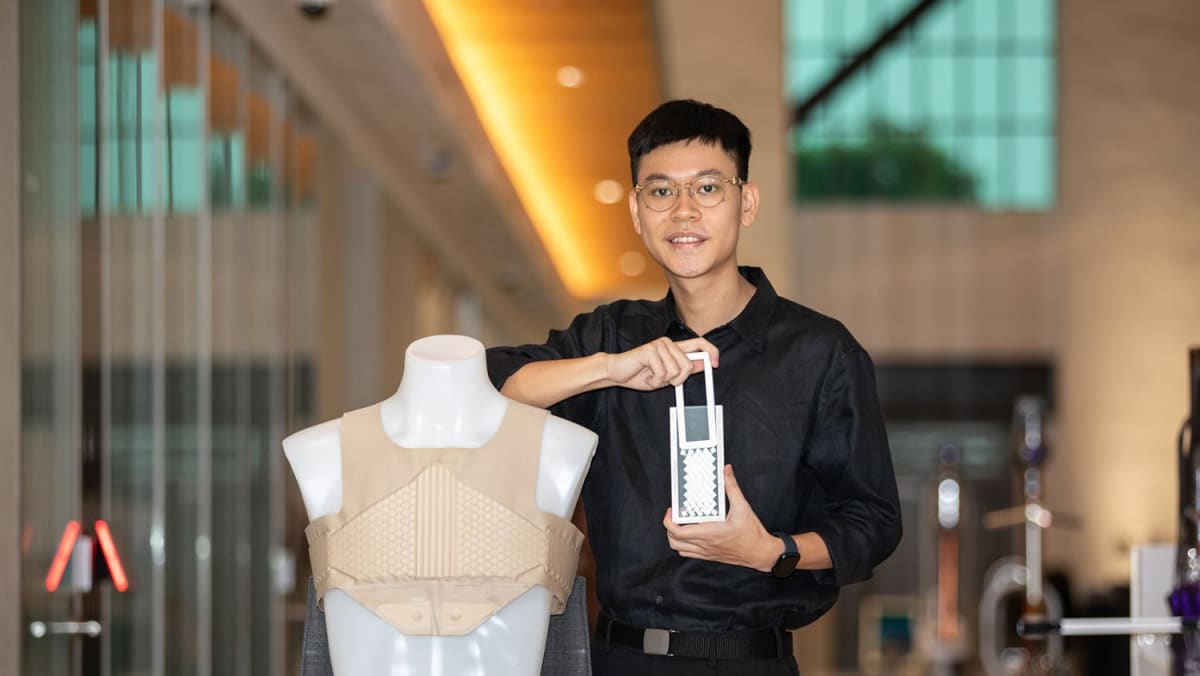
SINGAPORE — Born with a congenital heart defect called pulmonary stenosis, which affected the function of his heart’s valves, Mr Siew E Ian first required open heart surgery when he was just two weeks old.
He needed another one in 2021, when he was 22.
Then, one thing struck him after his second procedure: The supportive chest braces he had to wear after surgery to support the healing of his sternum — a long, flat bone located in the middle of one’s chest — did not provide adequate pressure on the upper half of the chest to work properly.
Mr Siew also felt that the elastic materials used in the braces can feel very restrictive by making the user feel a constant pressure around the chest.
This hinders proper breathing patterns in patients and instead encourages perspiration near wounds, which can increase the risk of infection during recovery.
“During my recovery period, all the current solutions were not extremely adequate. So with my skill sets, I thought, why not I just create my own solution and hopefully, it could bring relief to a larger population”, Mr Siew said.
The 24-year-old is a recent graduate of the National University of Singapore (NUS) who majored in industrial design.
On Wednesday (Sept 13), he received an award for coming up with Auxobrace, a first-of-its-kind vest-like rehabilitation device that provides dynamic support and stability to the sternum during outpatient recovery, inspired by his own condition.
Auxobrace was this year’s national winner of the James Dyson Award, named after the British inventor and billionaire who founded household appliances firm Dyson.
The James Dyson Award is an international design award aimed at inspiring the “next generation of design engineers”.
Two other projects from Singapore, a braille embosser called Project Mimir and a floating device called Thermal Floater that converts solar-thermal energy into electricity were named as national runners-up.
The three projects were chosen from 48 submissions across six Singapore universities.
The three winners will progress to the next round of international shortlisting from all national winners across 30 participating countries.
The top 20 international entries shortlisted from around 90 finalists will be announced on Oct 18, and one international winner, two runners-up and one sustainability winner chosen by Mr Dyson will be announced on Nov 15.
The international winner will get S$48,000 and the two runners-up will receive S$8,000.
DESIGNING ‘FROM THE HEART’
During open heart surgery, the sternum is split so that doctors are able to directly operate on the heart.
In Singapore, an average of six to eight open heart surgeries are done daily, Dyson said in its media release.
The healing of the sternum during post-surgery recovery typically ranges from a period of three to four months, and patients wear rehabilitation devices to support the chest and speed up the healing process.
Mr Siew’s experience as both user and designer gave him a “very big motivational push” to develop a solution to the problems he faced as a recovering patient.
Associate Professor Ngiam Kee Yuan, a judge at this year’s award, said that Auxobrace “offers a pioneering engineering solution for post-open-heart surgery rehabilitation that does not yet have an effective solution”.
“Beyond just cardiac care, the same engineering principles used in Auxobrace also hold the potential for a multitude of other surgical and rehabilitative applications,” he added.
Assoc Prof Ngiam is also group chief technology officer at the National University Health System.
Mr Siew told TODAY that he developed more than 10 prototypes of Auxobrace, and sought feedback from medical workers and patients who have recovered from open heart surgery at the National University Hospital.
Instead of applying the necessary inward pressure on the sternum, one of his earlier prototypes made of polystyrene beads could only compress the sides of the chest, which can cause pain and discomfort during recovery.
He later found inspiration in soft robotics, a subfield of robotics that uses flexible materials to mimic living organisms.
This led him to Auxobrace’s current design of 3D-printed internal structures that “can compress and bend with precise control” when air is removed with a mini vacuum pump.
Auxobrace is made of thermoplastic polyurethane fabric, the same material used to make inflatable airplane neck pillows.
The material and Auxobrace’s cube-like internal structure allow the device to provide targeted pressure and inward force on the sternum.
Mr Siew has successfully applied for a provisional patent for Auxobrace and will continue to develop it in his work as a research design engineer at the NUS Centre for Additive Manufacturing.
He described his victory as “still a bit surreal”.
“I hope to see more design engineers design from the heart… so that more impactful designs and solutions could be created,” he said.